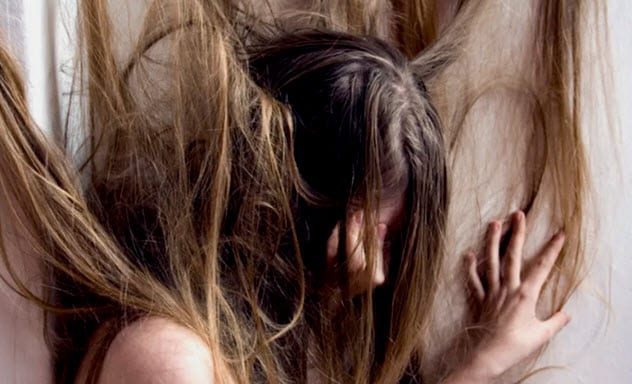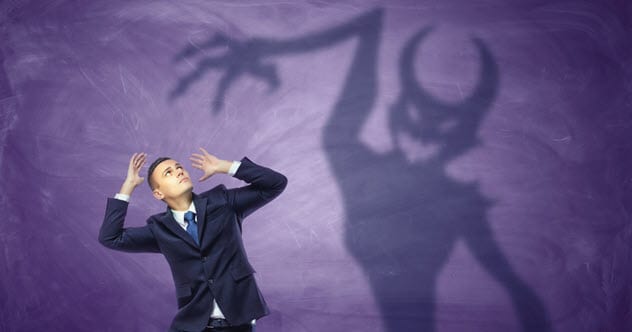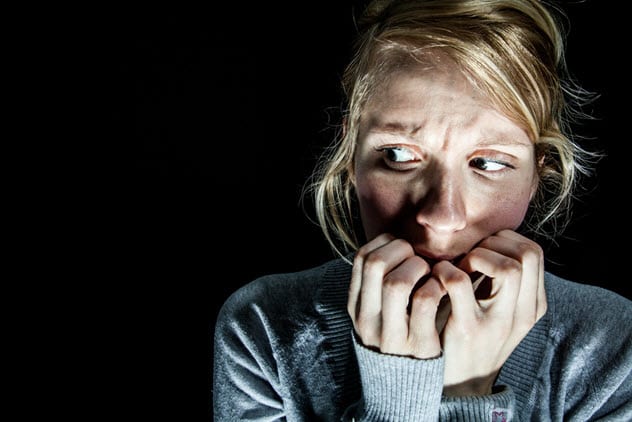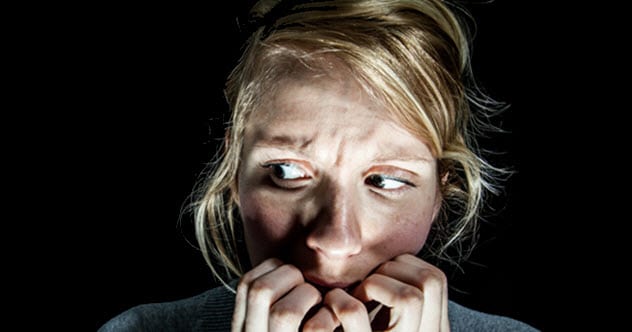Let’s face it, some things are creepy or scary. Someone might become fearful when coming across a venomous snake. That fear is healthy because it tells us to stay away from the snake whose venom could kill us. But what if a rubber snake sends someone into scream-filled terror? Then that person might have a phobia, an irrational fear of something.
The term “phobia” comes from the Greek word phobos (“fear”). Some phobias are common, such as coulrophobia (fear of clowns) or arachnophobia (fear of spiders). Other phobias are so rare or bizarre that you may have never heard of them.
10 Ergophobia

People suffer from workplace anxiety from time to time—for example, when you have that important presentation to give in front of a big audience. However, with ergophobia, the sufferer has an irrational fear of work.
Ergophobia comes from the Greek ergon (“work”). The phobia may include the combined fears of speaking in groups, socializing, and failing at tasks. The anxiety is severe enough to cause the person to leave work early or not be able to go to work at all. This fear persists even if the work or workplace changes.[1]
One treatment for this condition is exposure therapy, in which the patient is gradually exposed to his frightening work environment until he no longer fears it. Another treatment is cognitive behavioral therapy, where situations are created to teach the correct behavior. To discover more about the phobias treated by these methods, check out the Top 10 Bizarre Phobias People Suffer From.
9 Chaetophobia

Most people would love to have a full head of hair. However, people with chaetophobia (aka “trichopathophobia” and “trichophobia”) have an irrational fear of hair.
Chaetophobia comes from the Greek word khaite (“loose, flowing hair”). The phobia can be fear of hair on your own body or fear of loose hair. The person can also be afraid of other people’s hair and even animal hair.
The condition can arise from a bad experience, like getting a terrible haircut. It can also be related to stress, anxiety, depression, or other mental health conditions. Another possible link is the mental disorder trichotillomania, in which a person compulsively pulls out his hair.[2]
There are various treatments for this condition. A doctor may prescribe antianxiety medication depending on the severity of the phobia. Neurolinguistic programming is used in psychotherapy. Exposure therapy can also be used to gradually expose the person to hair over time. For more hair-raising facts, check out 10 Weird Ways Human Hair Has Been Used.
8 Daemonophobia

People with an irrational fear of the evil entities called demons have daemonophobia, which comes from the Greek word daemono (“demon”). This phobia is closely associated with satanophobia (fear of Satan) and hadephobia (fear of hell).
Someone can develop daemonophobia from religious beliefs that demons might possess them in a negative way or otherwise cause harm. The phobia can also be triggered by a negative experience with a Ouija board or a seance.[3]
Treatments include hypnotherapy, counseling, and neurolinguistic programming (NLP). In NLP, your self-awareness is improved by helping you understand how you view the world. It also shows that unhelpful thoughts and behavioral patterns need to be changed. Then again, better safe than sorry. Here are the 10 Demons You Should Probably Try To Avoid.
7 Hexakosioihexekontahexaphobia

Hexakosioihexekontahexaphobia comes from the Greek word hexiekatohexintahexi (“six hundred and sixty-six”). It is the fear of the number 666, considered the mark of the beast. This comes from the Bible, which states in Revelation 13:18: “Let the person who has insight calculate the number of the beast, for it is the number of a man. That number is 666.”
People with this phobia will go out of their way to avoid this number. For example, if an order totals $6.66, then the person will add something to the order or put something back to change the price.[4]
One of the best-known examples of fear concerning this number is the infamous Highway 666. Stretching through Colorado, Utah, and New Mexico, this road was considered dangerous. People associated the cause with the satanic numbering. In 2003, the route was officially changed to US 491.
Treatment for this phobia includes evaluation of one’s religious beliefs and cognitive behavioral therapy. Talk therapy is also an effective treatment. Relaxation techniques such as guided meditation, yoga, deep breathing, and visualization can help as well. If you suffer from a phobia like this, you’re not alone. Check out 10 Well-Known People and their Phobias.
6 Allodoxaphobia

If you fear someone else’s opinion of you, then you may have allodoxaphobia, which comes from the Greek words allo (“different”) and dox (“opinion”). Negative or traumatic events, such as constant criticism as a child, may be behind the development of this phobia.
Allodoxaphobia is a rare social phobia. Sufferers may not participate in activities because they fear other people’s judgment of them. They cannot take feedback of any kind, positive or negative. They can be socially withdrawn or even depressed. This may cause the person to miss out on events and opportunities.[5]
Treatments for allodoxaphobia are extensive. Yoga, meditation, and exercise are some examples. Exposure therapy can also be used. Cognitive behavioral therapy, dialectical behavior therapy, and medications are other treatments. However, most sufferers probably don’t have it nearly as bad as the people in these 10 Scandalous Relationships That Changed Opinions On Divorce.
5 Genuphobia

Genuphobia, which comes from the Latin word genu (“knee”), is the fear of knees. People with this phobia have a fear of their own knees, someone else’s knees, or kneeling.
This phobia can result from trauma to that person’s or another individual’s knees. It may even be caused by seeing kneecaps broken in movies. This phobia can also be triggered by certain cultures where it is customary to wear conservative dress and cover the knees.[6]
Cognitive behavioral therapy or medications such as antidepressants are possible treatments. Exposure therapy is also used. A person with this phobia can also try journaling, exercise, and meditation. To find out more about some truly weird treatments used for other mental or emotional disorders, check out 10 Of The Strangest Psychotherapy Techniques.
4 Geniophobia

Geniophobia, which comes from the Greek word genie (“chin”), is the fear of chins. No one is sure what causes this phobia, but several factors can come into play such as genetics, past experiences, and upbringing.
If someone has geniophobia, that person will try to avoid the source of his fear by isolating himself. This may temporarily help anxieties related to the phobia, but it does not cure the individual.[7]
Treatments include talk therapy, cognitive behavioral therapy, and exposure therapy. Dialectical behavior therapy is another type of treatment. Yoga and mindfulness are good self-help options. It might also help to know that even strong people suffer from weird phobias. You can read more at 10 Surprising Phobias Of ‘Fearless’ Historical Leaders.
3 Arachibutyrophobia

Have you ever made a sandwich slathered with peanut butter, only to have it stick to the roof of your mouth? This scenario would send someone with arachibutyrophobia into a panic because he is afraid of having peanut butter stick to the roof of his mouth.
Arachibutyrophobia is thought to be rooted in a fear of choking, which may be linked to a past experience of doing so. Women may have a higher risk of developing this phobia.[8]
Treatments include exposure therapy and cognitive behavioral therapy. Yoga, meditation, and deep breathing can also be used. Medications such as antianxiety drugs may be prescribed by a doctor. You can read more about the symptoms of this phobia at 10 Surprising Peanut Butter Facts.
2 Hippopotomonstrosesquippedaliophobia

Ironically, hippopotomonstrosesquippedaliophobia is the name for the fear of long words. It also goes by the name sesquipedalophobia. Even though it is not a recognized phobia and some consider it fictional, it is a real thing.
The word hippopotomonstrosesquippedaliophobia can be broken down into several segments. The first part, hippo, comes from the Greek meaning “horse.” The next part, potamos, means “river” in Greek. “Hippopotamine” refers to something very large. Then there is monstr, Latin for “monstrous being.” Finally, sesquippedalio comes from the Latin meaning “measures a foot and a half long.”
Like many phobias, it probably came into being through a traumatic experience sometime during someone’s life. If the person had trouble with pronouncing a long word in front of others and was ridiculed as a result, this could have caused the onset of this particular phobia.[9]
Exposure therapy is a common treatment. Talk therapy or cognitive behavioral therapy can also be effective. Self-help treatments such as practicing mindfulness, meditation, and deep breathing may help to control the anxiety. Listverse might also be able to help you out—for free. Click here to discover the Top 10 Words You’re Saying Wrong.
1 Phobophobia

Phobophobia means “fear of fear.” A person who suffers from this is afraid of developing a phobia. If the individual already has a phobia, then he is afraid of developing a new phobia, which is the more likely manifestation of this condition.
By worrying that he may develop a phobia about something, the person’s anxiety level can increase. Over time, this continued anxiety will be a self-fulfilling prophecy, and the individual will develop a phobia.[10]
Treatment can be psychotherapy, such as cognitive behavioral therapy and neurolinguistic programming. Various self-help methods include yoga and meditation.
Depending on the treatments your doctor prescribes for your ailments, you may even develop phobias from the cures. Get ready to cringe when you click over to 10 Strange Creepy-Crawly Medical Treatments That Actually Work.
We Publish Lists By Our Readers! Submit Here . . .
